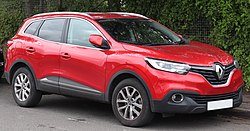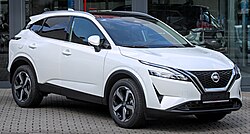Top Qs
Timeline
Chat
Perspective
Renault–Nissan Common Module Family
Motor vehicle platform From Wikipedia, the free encyclopedia
Remove ads
The Common Module Family (CMF) is a modular architecture concept jointly developed by car manufacturers Nissan and Renault through their Renault–Nissan–Mitsubishi Alliance partnership.[1][2] The concept covers a wide range of vehicle platforms.[3][4]
Remove ads
Main features
CMF is aimed at reducing manufacturing costs and competing with similar previous concepts as Volkswagen Group's MQB.[2] It consists of five groups of interchangeable, compatible modules: engine bay, cockpit, front underbody, rear underbody and electrical/electronic.[2] According to the companies involved in the development, CMF is not a conventional platform but rather a manufacturing system which can be applied to different vehicles.[5] The actual platforms are built combining a limited set of common modules: a single module can be used for different platforms, covering different classes of vehicles, and so allowing a greater standardisation of components between both Nissan, Renault and Mitsubishi.[6]
Remove ads
Applications
Summarize
Perspective
The Renault–Nissan Alliance announced various variants developed using CMF, which are CMF-C (D for large and mid-sized vehicles; examples are the third-generation Nissan X-Trail and the second-generation Nissan Qashqai), CMF-B for subcompacts/supermini, CMF-A for smaller vehicles, and CMF-EV for alliance wide BEV.[1] The CMF will initially be used in approximately 14 vehicle models worldwide with an estimated production of 1.6 million units annually.[7] The first CMF vehicles were introduced through 2013 with Nissan's CMF-C/D models.
Dacia, Datsun, Dongfeng, Mercedes-Benz, Mitsubishi, Nissan, Renault, and Venucia have all used CMF platforms. Alpine and Lada are expected to begin using the platforms in 2025.
CMF-A
The CMF-A platform underpins various vehicles in the A-segment or city car segment. The first CMF-A car, the Renault Kwid, was launched into the Indian market in September 2015.[2][8][9] The platform currently also supports electric powertrain, for the Renault City K-ZE and its rebadged models.
Vehicles using platform (calendar years):
- Renault Kwid (2015–present)[8]
- Datsun redi-GO (2016–2022)[10]
- Renault Kwid
- Datsun redi-Go
CMFA-EV
The CMFA-EV is the name used for the CMF-A platform that is adapted for battery electric vehicle application.[11]
Vehicles using platform (calendar years):
- Renault City K-ZE (2019–present)
- Dongfeng Aeolus EX1 (2019–2021)
- Dongfeng Fengxing T1 (2019–2021)
- Dongfeng Fengguang E1 (2019–2024)
- Dongfeng Nano Box (2022–2024)
- Venucia e30 (2019–2023)
- Dacia Spring Electric (2021–present)
- Renault City K-ZE
- Venucia e30
- Dongfeng Aeolus EX1
- Dongfeng Nano Box
- Dacia Spring Electric
CMF-A+
The CMF-A+ platform is a larger derivative of the CMF-A platform. The platform is mainly utilized for low-cost B-segment or subcompact vehicles for emerging markets.
Vehicles using platform (calendar years):
- Renault Triber (2019–present)[12]
- Renault Kiger (2021–present)[13]
- Nissan Magnite — DD0 (2020–present)[14]
- Renault Triber
- Renault Kiger
- Nissan Magnite
CMF-B
CMF-B HS
The CMF-B HS (high specifications) platform[15] underpins higher end vehicles in the B-segment/supermini or subcompact segment.[15] The platform replaces the B platform and V platform.
Vehicles using platform (calendar years):
- Renault Clio V (2019–present)[16]
- Mitsubishi Colt (2023–present)[17]
- Renault Clio VI (2025–present)
- Renault Captur II (2019–present)[18]
- Mitsubishi ASX (2023–present)
- Renault Arkana/Mégane Conquest/Renault Samsung XM3 (South Korean-built only, 2020–present)
- Renault Symbioz (2024–present)
- Mitsubishi Grandis (2025–present)
- Nissan Juke — F16 (2019–present)[19]
- Nissan Kicks — P16 (2024–present)
- Nissan Note — E13 (2020–present)[citation needed]
- Renault Clio V
- Renault Clio VI
- Renault Captur
- Renault Arkana
- Renault Symbioz
- Nissan Juke
- Nissan Kicks
- Nissan Note
- Nissan Note Aura
- Mitsubishi Colt
- Mitsubishi ASX
- Mitsubishi Grandis
CMF-B LS
The CMF-B LS (low specifications) platform[20][21] underpins budget models in the B-segment/supermini or subcompact segment.[15] The platform replaces the B0 platform and M0 platform.
Vehicles using platform (calendar years):
- Dacia Logan III (2020–present)[22]
- Renault Taliant (2021–2025)[23]
- Dacia Sandero III (2020–present)[24]
- Dacia Jogger (2021–present)
- Dacia Duster III (2023–present)
- Nissan Tekton (2025–present)
- Dacia Bigster (2024–present)
- Lada Iskra (2025–present)
- Renault Boreal (2025)
- Dacia Logan
- Dacia Sandero
- Dacia Jogger
- Dacia Duster III
- Dacia Bigster
- Lada Iskra
- Renault Taliant
- Renault Boreal
RMP
The RMP platform is presented as a new evolution of the CMF-B LS platform. It is aimed at emerging markets. The first vehicle using it is the Renault Kardian.[25][26][27]
Vehicles using platform (calendar years):
- Renault Kardian (2023–present)[27]
- Renault Kardian
CMF-B EV / AmpR Small
CMF-B EV (electric vehicle, also known as CMF-BEV, CMFB-EV or, since November 2023, as AmpR Small) is the CMF-B platform variant that has been adapted for low-cost B-segment battery electric vehicles. It shares approximately 1⁄2 the components of the CMF-B platform.[28] The CMF-B EV platform was designed to reduce production cost and increase vehicle efficiency compared to the B-segment Renault Zoe, which used a bespoke platform.[29] Two types of traction batteries using NMC chemistry are expected: "high-performance" and "affordable" variants,[28] with the goal of reducing battery cost below US$80/kW-hr by 2030.[30] In November 2023, Renault subsidiary Ampere renamed this platform to AmpR Small.[31] With the Twingo E-Tech, an LFP battery option becomes available.[32] In December 2025, it was announced that Ford would produce two new cars for the European market based on the platform.[33][34]
Vehicles using platform (calendar years):
- Renault Twingo E-Tech (2026 announced)
- Renault 4 E-Tech (2025–present)[35]
- Renault 5 E-Tech (2024–present)[36]
- Alpine A290 (2024–present)
- Nissan Micra EV (2025–present)[37][36]
- Renault Twingo E-Tech
- Renault 4 E-Tech
- Renault 5 E-Tech
- Alpine A290
- Nissan Micra EV
CMF-C/D
The CMF-C/D platform underpins various vehicles in the C-segment and above. The platform replaces the C platform and D platform.
Vehicles using platform (calendar years):
- Renault Espace V (2015–2023)
- Renault Kadjar (2015–2022)[38][39]
- Renault Talisman/Renault Samsung SM6 (2015–2025)
- Renault Mégane IV (2016–2024)
- Renault Koleos II/Renault Samsung QM6 (2016–present)[40]
- Renault Scénic IV (2016–2022)
- Renault Austral (2022–present)
- Renault Espace VI (2023–present)
- Renault Rafale (2023–present)
- Renault Kangoo III (2021–present)[41]
- Kangoo E-Tech Electric (2021–present)
- Nissan Qashqai/Rogue Sport — J11 (2013–2022)
- Nissan X-Trail/Rogue — T32 (2013–2020)
- Nissan Pulsar/Tiida — C13 (2014–present)[42]
- Nissan Sentra/Sylphy — B18 (2019–present)[43]
- Nissan Sentra/Sylphy — B19 (2026–present)
- Nissan X-Trail/Rogue — T33 (2020–present)
- Nissan Qashqai — J12 (2021–present)
- Nissan Townstar — (2021–present)
- Townstar EV — (2021–present)
- Mitsubishi Outlander — GN (2021–present)
- Nissan Rogue PHEV — (2026–present)
- Mercedes-Benz Citan/T-Class — (2021–present)[41]
- Mercedes-Benz eCitan/EQT — (2021–present)[41]
- Renault Espace V
- Renault Kadjar
- Renault Talisman
- Renault Mégane
- Renault Scénic
- Renault Koleos
- Renault Kangoo
- Renault Austral
- Renault Espace VI
- Nissan X-Trail
- Nissan Rogue Sport
- Nissan Pulsar
- Nissan Sentra
- Nissan Rogue
- Mitsubishi Outlander
- Nissan Qashqai
- Nissan Townstar
- Mercedes Citan
CMF-EV / AmpR Medium
The AmpR Medium platform (previously CMF-EV until November 2023) underpins battery electric vehicles.[44] It replaces the EV platform used by the Nissan Leaf. In November 2023, Renault subsidiary Ampere renamed this platform to AmpR Medium.[45]
Vehicles using platform (calendar years):
- Renault Megane E-Tech Electric (2021–present)
- Renault Scenic E-Tech (2023–present)
- Mitsubishi Eclipse Cross (2025–present)
- Nissan Ariya (2022–present)[46]
- Nissan Leaf (2025–present)[47]
- Alpine A390 (2025–present)[48]
- Renault Mégane E-Tech Electric
- Renault Scenic E-Tech
- Nissan Ariya
- Nissan Leaf
- Alpine A390
- Mitsubishi Eclipse Cross
Remove ads
References
Wikiwand - on
Seamless Wikipedia browsing. On steroids.
Remove ads



























































